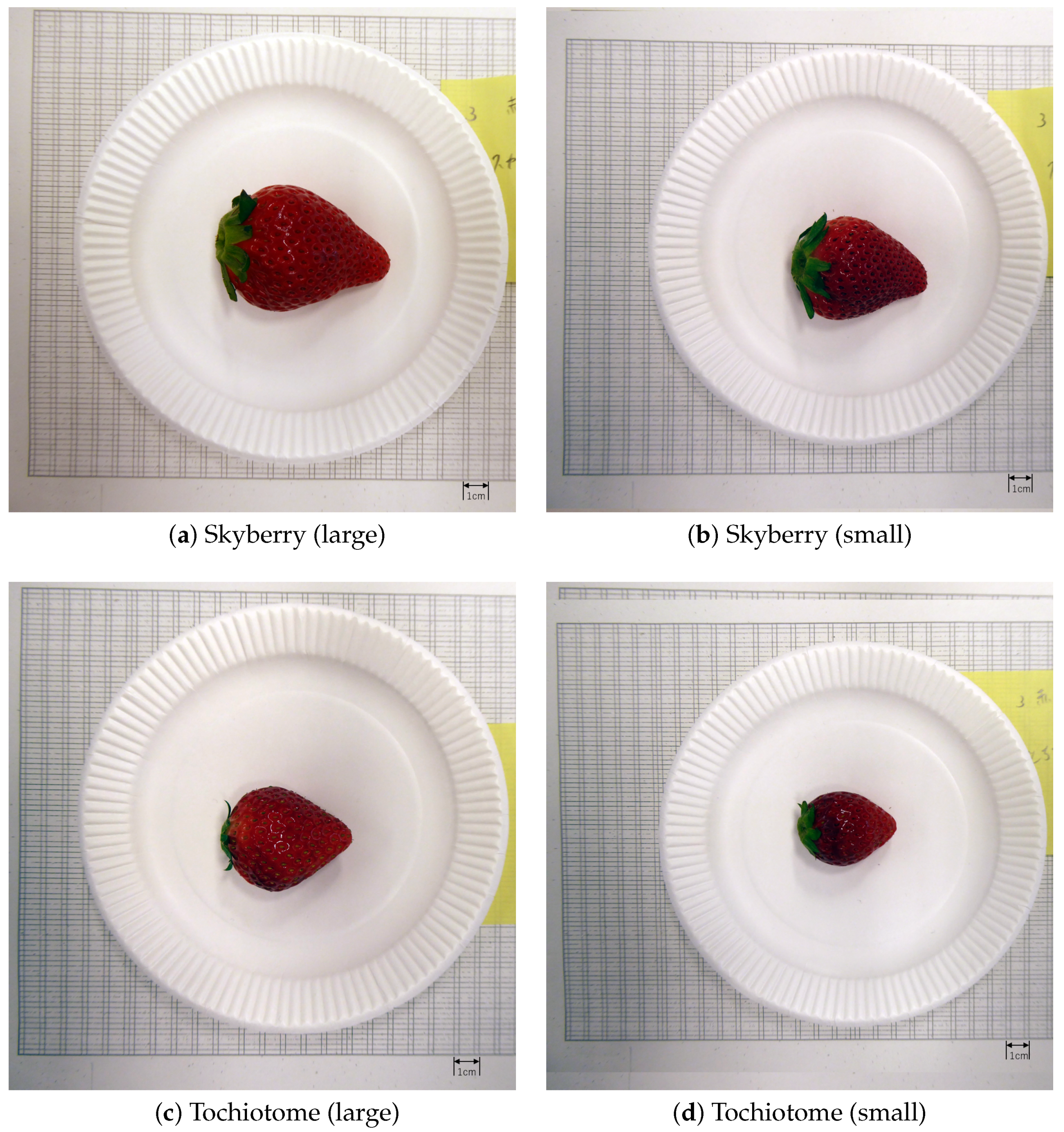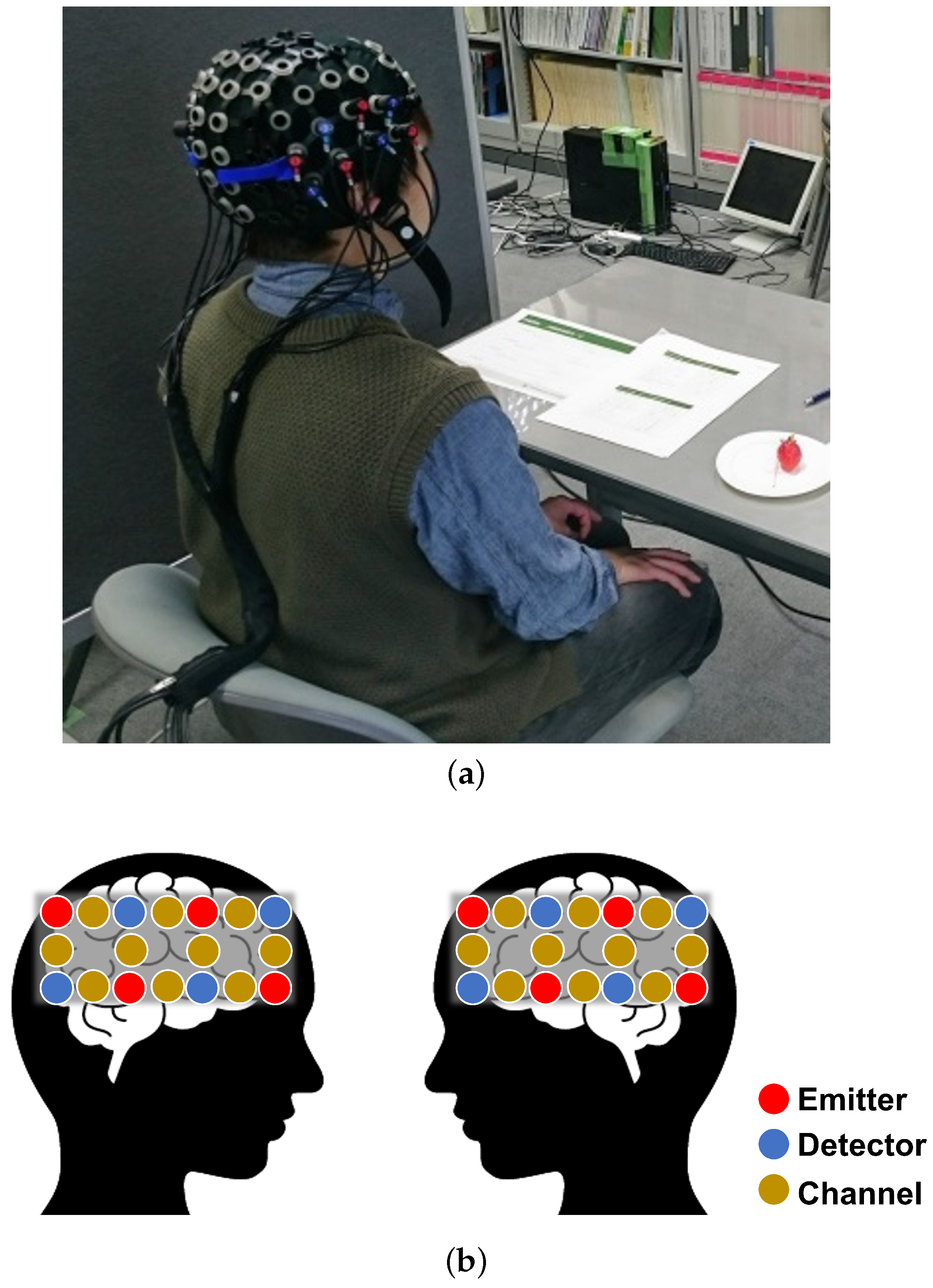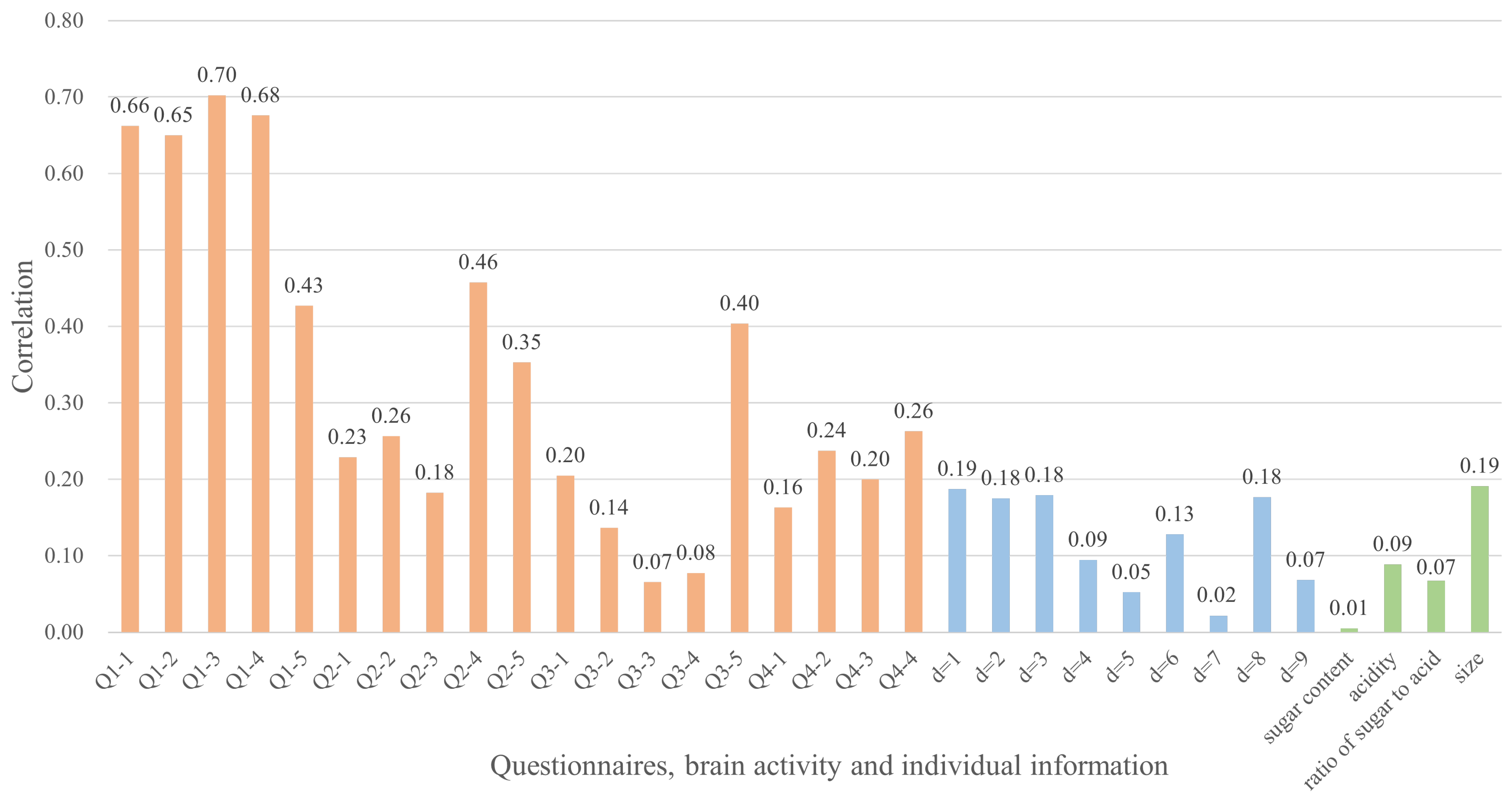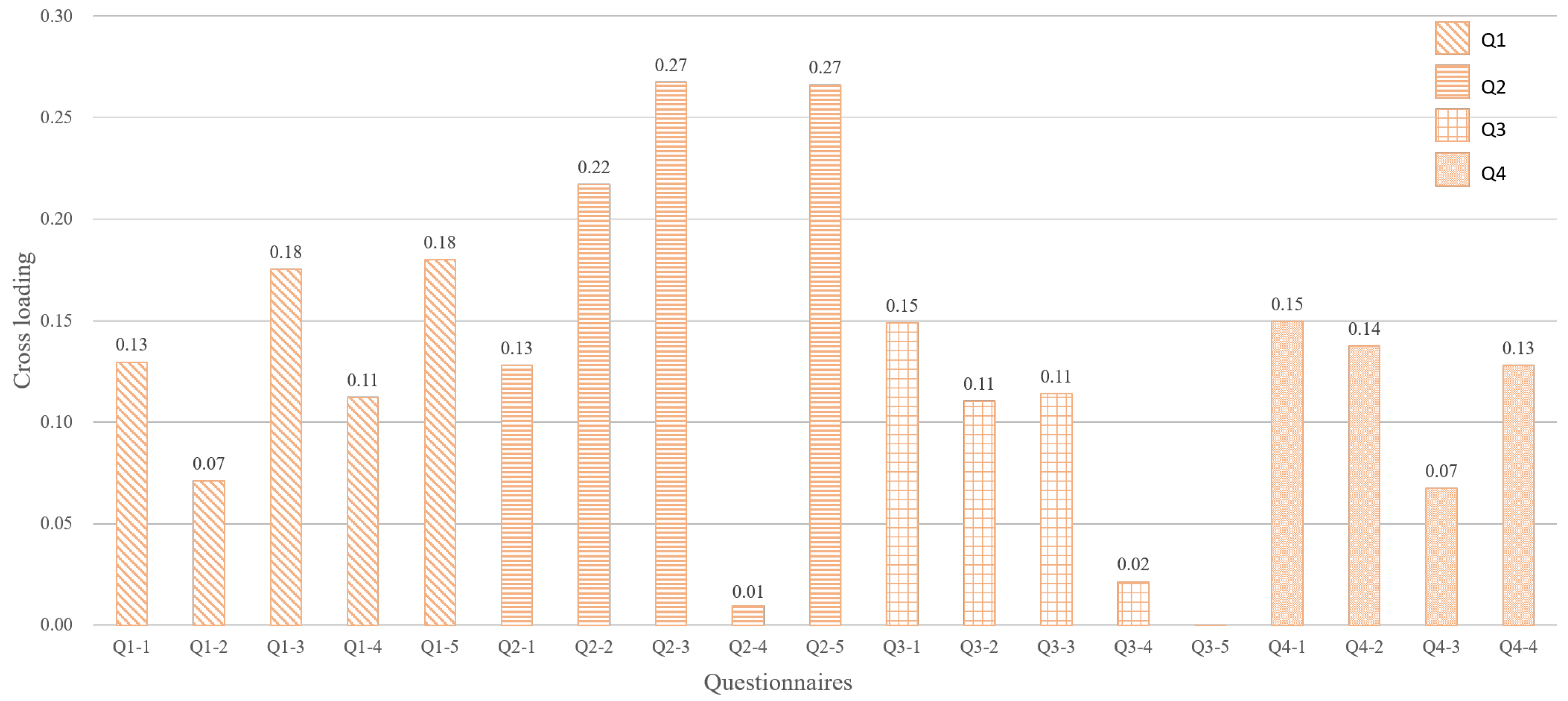Trial Analysis of the Relationship between Taste and Biological Information Obtained While Eating Strawberries for Sensory Evaluation
Abstract
1. Introduction
2. Procedure of Data Acquisition and Constructed Dataset
2.1. Procedure of Data Acquisition

2.2. Dataset
2.2.1. VAS Obtained via User Evaluation
2.2.2. Questionnaires Obtained via User Evaluation
- 1.
- Reward factor
- (1-1)
- The degree of desire caused by the addictiveness of the food;
- (1-2)
- The degree of level of difficulty in inhibiting urges to eat;
- (1-3)
- The degree of level of difficulty in inhibiting eating the food;
- (1-4)
- The degree of sense of satiety recognized by eating the food;
- (1-5)
- The degree of sense of rewarding ingredients perceived by eating the food.
- 2.
- Cultural factor
- (2-1)
- The degree of repeated exposure to the food;
- (2-2)
- The degree of dietary accustomedness to the food;
- (2-3)
- The degree of similarity with an accustomed food;
- (2-4)
- The degree of embeddedness of the food as a home-cooked taste;
- (2-5)
- The degree of entrenched preference for a certain food.
- 3.
- Information factor
- (3-1)
- The degree of visual information of the food;
- (3-2)
- The degree of publicity of the food;
- (3-3)
- The degree of health information of the food;
- (3-4)
- The degree of perceived safeness of the food;
- (3-5)
- The degree of perceived value for the price of the food.
- 4.
- Appearance factor
- (4-1)
- The degree of the size of the food;
- (4-2)
- The degree of brilliance of the food;
- (4-3)
- The degree of gloss of the food;
- (4-4)
- The degree of scent of the food.
2.2.3. fNIRS Data
2.2.4. Individual Information
3. Correlation Analysis between Heterogeneous Data
3.1. Analysis of Correlation between Taste and Other Data
3.2. Analysis of Potential Correlation between Heterogeneous Data through CCA
4. Experimental Results
4.1. Results of Correlation between Taste and Other Data
4.2. Results of the Potential Correlation between Heterogeneous Data via CCA
5. Conclusions
Author Contributions
Funding
Institutional Review Board Statement
Informed Consent Statement
Data Availability Statement
Acknowledgments
Conflicts of Interest
References
- Ikegaya, A.; Toyoizumi, T.; Kosugi, T.; Arai, E. Taste and palatability of strawberry jam as affected by organic acid content. Int. J. Food Prop. 2020, 23, 2087–2096. [Google Scholar] [CrossRef]
- Darrow, G.M. The Strawberry: History, Breeding and Physiology; Holt, Rinehart & Winston: Ney York, NY, USA, 1966. [Google Scholar]
- Ariza, M.T.; Reboredo-Rodríguez, P.; Cervantes, L.; Soria, C.; Martínez-Ferri, E.; González-Barreiro, C.; Cancho-Grande, B.; Battino, M.; Simal-Gándara, J. Bioaccessibility and potential bioavailability of phenolic compounds from achenes as a new target for strawberry breeding programs. Food Chem. 2018, 248, 155–165. [Google Scholar] [CrossRef] [PubMed]
- Zuo, Y.; Zhang, J.; Zhao, R.; Dai, H.; Zhang, Z. Application of vermicompost improves strawberry growth and quality through increased photosynthesis rate, free radical scavenging and soil enzymatic activity. Sci. Hortic. 2018, 233, 132–140. [Google Scholar] [CrossRef]
- Ayala-Zavala, J.F.; Wang, S.Y.; Wang, C.Y.; González-Aguilar, G.A. Effect of storage temperatures on antioxidant capacity and aroma compounds in strawberry fruit. LWT-Food Sci. Technol. 2004, 37, 687–695. [Google Scholar] [CrossRef]
- Jiang, Y.; Shiina, T.; Nakamura, N.; Nakahara, A. Electrical conductivity evaluation of postharvest strawberry damage. J. Food Sci. 2001, 66, 1392–1395. [Google Scholar] [CrossRef]
- Aaby, K.; Grimsbo, I.H.; Hovda, M.B.; Rode, T.M. Effect of high pressure and thermal processing on shelf life and quality of strawberry purée and juice. Food Chem. 2018, 260, 115–123. [Google Scholar] [CrossRef]
- Kovačević, D.B.; Putnik, P.; Dragović-Uzelac, V.; Vahčić, N.; Babojelić, M.S.; Levaj, B. Influences of organically and conventionally grown strawberry cultivars on anthocyanins content and color in purees and low-sugar jams. Food Chem. 2015, 181, 94–100. [Google Scholar] [CrossRef]
- Koyuncu, M.A.; Dilmaçünal, T. Determination of vitamin C and organic acid changes in strawberry by HPLC during cold storage. Not. Bot. Horti Agrobot.-Cluj-Napoca 2010, 38, 95–98. [Google Scholar]
- Paparozzi, E.T.; Meyer, G.E.; Schlegel, V.; Blankenship, E.E.; Adams, S.A.; Conley, M.E.; Loseke, B.; Read, P.E. Strawberry cultivars vary in productivity, sugars and phytonutrient content when grown in a greenhouse during the winter. Sci. Hortic. 2018, 227, 1–9. [Google Scholar] [CrossRef]
- Ikegaya, A.; Toyoizumi, T.; Ohba, S.; Nakajima, T.; Kawata, T.; Ito, S.; Arai, E. Effects of distribution of sugars and organic acids on the taste of strawberries. Food Sci. Nutr. 2019, 7, 2419–2426. [Google Scholar] [CrossRef]
- Banerjee, R.; Tudu, B.; Bandyopadhyay, R.; Bhattacharyya, N. A review on combined odor and taste sensor systems. J. Food Eng. 2016, 190, 10–21. [Google Scholar] [CrossRef]
- Keast, R.S.; Breslin, P.A. An overview of binary taste–taste interactions. Food Qual. Prefer. 2003, 14, 111–124. [Google Scholar] [CrossRef]
- Yin, W.; Hewson, L.; Linforth, R.; Taylor, M.; Fisk, I.D. Effects of aroma and taste, independently or in combination, on appetite sensation and subsequent food intake. Appetite 2017, 114, 265–274. [Google Scholar] [CrossRef] [PubMed]
- Lee, S.K.; Bae, M.; Kim, H. Future of IoT networks: A survey. Appl. Sci. 2017, 7, 1072. [Google Scholar] [CrossRef]
- Al-Garadi, M.A.; Mohamed, A.; Al-Ali, A.K.; Du, X.; Ali, I.; Guizani, M. A survey of machine and deep learning methods for Internet of things (IoT) security. IEEE Commun. Surv. Tutorials 2020, 22, 1646–1685. [Google Scholar] [CrossRef]
- Alfian, G.; Syafrudin, M.; Ijaz, M.F.; Syaekhoni, M.A.; Fitriyani, N.L.; Rhee, J. A personalized healthcare monitoring system for diabetic patients by utilizing BLE-based sensors and real-time data processing. Sensors 2018, 18, 2183. [Google Scholar] [CrossRef]
- Srinivas, J.; Das, A.K.; Kumar, N.; Rodrigues, J.J. Cloud centric authentication for wearable healthcare monitoring system. IEEE Trans. Dependable Secur. Comput. 2018, 17, 942–956. [Google Scholar] [CrossRef]
- Kamikawa, K.; Maeda, K.; Ogawa, T.; Haseyama, M. Feature integration via semi-supervised ordinally multi-modal Gaussian process latent variable model. In Proceedings of the IEEE International Conference on Acoustics, Speech and Signal Processing, Toronto, ON, Canada, 6–11 June 2021; pp. 4130–4134. [Google Scholar]
- Maeda, K.; Kushima, T.; Takahashi, S.; Ogawa, T.; Haseyama, M. Estimation of interest levels from behavior features via tensor completion including adaptive similar user selection. IEEE Access 2020, 8, 126109–126118. [Google Scholar] [CrossRef]
- Moroto, Y.; Maeda, K.; Ogawa, T.; Haseyama, M. User-centric visual attention estimation based on relationship between image and eye gaze data. In Proceedings of the IEEE Global Conference on Consumer Electronics (GCCE), Nara, Japan, 9–12 October 2018; pp. 73–74. [Google Scholar]
- Moroto, Y.; Maeda, K.; Ogawa, T.; Haseyama, M. Few-shot personalized saliency prediction based on adaptive image selection considering object and visual attention. Sensors 2020, 20, 2170. [Google Scholar] [CrossRef]
- Xu, Y.; Gao, S.; Wu, J.; Li, N.; Yu, J. Personalized saliency and its prediction. IEEE Trans. Pattern Anal. Mach. Intell. 2018, 41, 2975–2989. [Google Scholar] [CrossRef]
- Akamatsu, Y.; Harakawa, R.; Ogawa, T.; Haseyama, M. Brain Decoding of Viewed Image Categories via Semi-Supervised Multi-View Bayesian Generative Model. IEEE Trans. Signal Process. 2020, 68, 5769–5781. [Google Scholar] [CrossRef]
- Higashi, T.; Maeda, K.; Ogawa, T.; Haseyama, M. Estimation of visual features of viewed image from individual and shared brain information based on fMRI data using probabilistic generative model. In Proceedings of the IEEE International Conference on Acoustics, Speech and Signal Processing, Toronto, ON, Canada, 6–11 June 2021; pp. 1335–1339. [Google Scholar]
- Higashi, T.; Maeda, K.; Ogawa, T.; Haseyama, M. Estimation of viewed images using individual and shared brain responses. In Proceedings of the IEEE Global Conference on Consumer Electronics (GCCE), Kobe, Japan, 13–16 October 2020; pp. 716–717. [Google Scholar]
- Higashi, T.; Maeda, K.; Ogawa, T.; Haseyama, M. Brain Decoding of Multiple Subjects for Estimating Visual Information Based on a Probabilistic Generative Model. Sensors 2022, 22, 6148. [Google Scholar] [CrossRef] [PubMed]
- Takada, S.; Togo, R.; Ogawa, T.; Haseyama, M. Generation of viewed image captions from Human brain activity via unsupervised text latent space. In Proceedings of the IEEE International Conference on Image Processing (ICIP), Abu Dhabi, United Arab Emirates, 25–28 October 2020; pp. 2521–2525. [Google Scholar]
- Takada, S.; Togo, R.; Ogawa, T.; Haseyama, M. Estimation Of visual contents based on question answering from human brain activity. In Proceedings of the IEEE International Conference on Image Processing (ICIP), Abu Dhabi, United Arab Emirates, 25–28 October 2020; pp. 61–65. [Google Scholar]
- Moroto, Y.; Maeda, K.; Ogawa, T.; Haseyama, M. Human-centric emotion estimation based on correlation maximization considering changes with time in visual attention and brain activity. IEEE Access 2020, 8, 203358–203368. [Google Scholar] [CrossRef]
- Onuma, T.; Maruyama, H.; Sakai, N. Enhancement of saltiness perception by monosodium glutamate taste and soy sauce odor: A near-infrared spectroscopy study. Chem. Senses 2018, 43, 151–167. [Google Scholar] [CrossRef]
- Minematsu, Y.; Ueji, K.; Yamamoto, T. Activity of frontal pole cortex reflecting hedonic tone of food and drink: fNIRS study in humans. Sci. Rep. 2018, 8, 16197. [Google Scholar] [CrossRef]
- Nakano, K.; Kyutoku, Y.; Sawa, M.; Matsumura, S.; Dan, I.; Fushiki, T. Analyzing comprehensive palatability of cheese products by multivariate regression to its subdomains. Food Sci. Nutr. 2013, 1, 369–376. [Google Scholar] [CrossRef]
- Hotelling, H. Relations between two sets of variates. Biometrika 1936, 28, 321–377. [Google Scholar] [CrossRef]
- Ono, Y. Prefrontal activity correlating with perception of sweetness during eating. In Proceedings of the International Conference on Complex Medical Engineering (CME), Kobe, Japan, 1–4 July 2012; pp. 125–130. [Google Scholar]
- Hu, C.; Kato, Y.; Luo, Z. An fNIRS Research on prefrontal cortex activity response to pleasant taste. J. Behav. Brain Sci. 2013, 2013. [Google Scholar] [CrossRef]
- Hasegawa, Y.; Tachibana, Y.; Sakagami, J.; Zhang, M.; Urade, M.; Ono, T. Flavor-enhanced modulation of cerebral blood flow during gum chewing. PLoS ONE 2013, 8, e66313. [Google Scholar] [CrossRef]
- Bartoshuk, L.M.; Duffy, V.B.; Fast, K.; Green, B.G.; Prutkin, J.; Snyder, D.J. Labeled scales (eg, category, Likert, VAS) and invalid across-group comparisons: What we have learned from genetic variation in taste. Food Qual. Prefer. 2003, 14, 125–138. [Google Scholar] [CrossRef]
- Goślińska, J.; Wareńczak, A.; Miedzyblocki, M.; Hejdysz, K.; Adamczyk, E.; Sip, P.; Chlebuś, E.; Gośliński, J.; Owczarek, P.; Woźniak, A.; et al. Wireless motion sensors—Useful in assessing the effectiveness of physiotherapeutic methods used in patients with knee osteoarthritis—Preliminary report. Sensors 2020, 20, 2268. [Google Scholar] [CrossRef] [PubMed]
- Kong, Y.; Posada-Quintero, H.F.; Chon, K.H. Real-time high-Level acute pain detection using a smartphone and a wrist-worn electrodermal activity sensor. Sensors 2021, 21, 3956. [Google Scholar] [CrossRef] [PubMed]
- Kurotobi, T.; Hoshino, T.; Kazami, Y.; Hayakawa, F.; Hagura, Y. Relationship between sensory analysis for texture and instrument measurements in model strawberry jam. J. Texture Stud. 2018, 49, 359–369. [Google Scholar] [CrossRef] [PubMed]
- Yeung, H.F.; Homwongpanich, K.; Michniuk, E.; Rovai, D.; Migliore, M.; Lammert, A.; Lahne, J. A tale of 3 scales: How do the 9-pt, labeled affective magnitude, and unstructured visual analog scales differentiate real product sets of fresh berries? Food Qual. Prefer. 2021, 88, 104109. [Google Scholar] [CrossRef]
- Pearson, K. LIII. On lines and planes of closest fit to systems of points in space. London Edinburgh Dublin Philos. Mag. J. Sci. 1901, 2, 559–572. [Google Scholar] [CrossRef]
- Horii, K.; Maeda, K.; Ogawa, T.; Haseyama, M. A human-centered neural network model with discriminative locality preserving canonical correlation analysis for image classification. In Proceedings of the IEEE International Conference on Image Processing (ICIP), Athens, Greece, 7–10 October 2018; pp. 2366–2370. [Google Scholar]
- Horii, K.; Maeda, K.; Ogawa, T.; Haseyama, M. Human-centered image classification via a neural network considering visual and biological features. Multimed. Tools Appl. 2020, 79, 4395–4415. [Google Scholar] [CrossRef]
- Toyoda, A.; Ogawa, T.; Haseyama, M. Semi-supervised multiple feature fusion for video preference estimation. In Proceedings of the IEEE International Conference on Acoustics, Speech and Signal Processing (ICASSP), Calgary, AB, Canada, 15–20 April 2018; pp. 891–895. [Google Scholar]
- Sugiyama, M. Local fisher discriminant analysis for supervised dimensionality reduction. In Proceedings of the International Conference on Machine Learning, Pittsburgh, PA, USA, 25–29 June 2006; pp. 905–912. [Google Scholar]
- Matsumoto, M.; Maeda, K.; Saito, N.; Ogawa, T.; Haseyama, M. Multi-modal label dequantized Gaussian process latent variable model for ordinal label estimation. In Proceedings of the IEEE International Conference on Acoustics, Speech and Signal Processing (ICASSP), Toronto, ON, Canada, 6–11 June 2021; pp. 3985–3989. [Google Scholar]
- Matsumoto, M.; Saito, N.; Maeda, K.; Ogawa, T.; Haseyama, M. Supervised fractional-order embedding multiview canonical correlation analysis via ordinal label dequantization for image interest estimation. IEEE Access 2021, 9, 21810–21822. [Google Scholar] [CrossRef]
- Maeda, K.; Ito, Y.; Ogawa, T.; Haseyama, M. Supervised fractional-order embedding geometrical multi-view CCA (SFGMCCA) for multiple feature integration. IEEE Access 2020, 8, 114340–114353. [Google Scholar] [CrossRef]
- Maeda, K.; Takahashi, S.; Ogawa, T.; Haseyama, M. Multi-feature fusion based on supervised multi-view multi-label canonical correlation projection. In Proceedings of the IEEE International Conference on Acoustics, Speech and Signal Processing (ICASSP), Brighton, UK, 12–17 May 2019; pp. 3936–3940. [Google Scholar]






| ID | Skyberry | Tochiotome | ||
|---|---|---|---|---|
| (Large) | (Small) | (Large) | (Small) | |
| 1 | 88 | 77 | 93 | 89 |
| 2 | 84 | 10 | 63 | 56 |
| 3 | 79 | 59 | 89 | 81 |
| 4 | 75 | 78 | 88 | 74 |
| 5 | 73 | 69 | 76 | 77 |
| 6 | 83 | 76 | 6 | 6 |
| 7 | 70 | 70 | 82 | 80 |
| 8 | 74 | 86 | 61 | 56 |
| 9 | 80 | 81 | 74 | 68 |
| 10 | 52 | 39 | 64 | 71 |
| 11 | 88 | 69 | 96 | 96 |
| 12 | 50 | 70 | 74 | 74 |
| 13 | 41 | 18 | 29 | 11 |
| 14 | 58 | 55 | 52 | 48 |
| 15 | 71 | 60 | 83 | 53 |
| 16 | 83 | 73 | 91 | 80 |
| 17 | 57 | 53 | 68 | 47 |
| 18 | 76 | 55 | 48 | 42 |
| 19 | 48 | 64 | 67 | 65 |
| Ave | 70 | 61 | 69 | 62 |
| Std | 15 | 20 | 23 | 24 |
| Q1 | Reward factor |
| Q1-1 | Does it taste like a habit? |
| Q1-2 | Does it taste like something you would want to pick up? |
| Q1-3 | Does one bite make you want to take another bite? |
| Q1-4 | Are you satisfied with the taste? |
| Q1-5 | Do you think that the food tastes good |
| because of its fatty sweetness and delicious taste? | |
| Q2 | Cultural factor |
| Q2-1 | Does it taste familiar to you? |
| Q2-2 | Have you ever eaten food that tasted the same or similar to you? |
| Q2-3 | Have you eaten food like this many times? |
| Q2-4 | Do you think your family will like the taste of this food? |
| Q2-5 | Did you like the taste since you were a child? |
| Q3 | Information factor |
| Q3-1 | Does the food look good to you? |
| Q3-2 | Have you seen this food in advertisements |
| or heard about it by word of mouth? | |
| Q3-3 | Have you ever heard of the health benefits? |
| Q3-4 | Do you feel comfortable with the ingredients? |
| Q3-5 | Do you think it looks expensive? |
| Q4 | Appearance factor |
| Q4-1 | Is the size of this food desirable? |
| Q4-2 | Does it look colorful and delicious? |
| Q4-3 | Does it look shiny and delicious? |
| Q4-4 | Do you think it smells good? |
| ID | Sugar Content(%) | Acidity (%) | Sugar to Acid Ratio | |||||||||
|---|---|---|---|---|---|---|---|---|---|---|---|---|
| Skyberry | Tochiotome | Skyberry | Tochiotome | Skyberry | Tochiotome | |||||||
| Large | Small | Large | Small | Large | Small | Large | Small | Large | Small | Large | Small | |
| 1 | 8.3 | 9.7 | 14.7 | 10.5 | 0.76 | 0.71 | 0.72 | 0.61 | 10.9 | 13.7 | 20.4 | 17.2 |
| 2 | 7.7 | 11.1 | 9.0 | 9.5 | 0.76 | 0.57 | 0.60 | 0.61 | 10.1 | 19.5 | 15.0 | 15.6 |
| 3 | 10.0 | 9.0 | 8.8 | 11.5 | 0.98 | 0.58 | 0.66 | 0.60 | 10.2 | 15.5 | 13.3 | 19.2 |
| 4 | 10.2 | 10.8 | 12.7 | 12.0 | 0.66 | 0.62 | 0.77 | 0.63 | 15.5 | 17.4 | 16.5 | 19.0 |
| 5 | 8.9 | 11.7 | 9.7 | 9.6 | 0.59 | 0.56 | 0.65 | 0.71 | 15.1 | 20.9 | 14.9 | 13.5 |
| 6 | 9.9 | 10.8 | 13.4 | 10.8 | 0.64 | 0.70 | 0.68 | 0.70 | 15.5 | 15.4 | 19.7 | 15.4 |
| 7 | 9.7 | 10.3 | 10.8 | 11.3 | 0.58 | 0.64 | 0.67 | 0.62 | 16.7 | 16.1 | 16.1 | 18.2 |
| 8 | 9.2 | 9.3 | 9.4 | 8.4 | 0.54 | 0.63 | 0.52 | 0.82 | 17.0 | 14.8 | 18.1 | 10.2 |
| 9 | 9.1 | 9.0 | 9.9 | 9.1 | 0.58 | 0.58 | 0.72 | 0.58 | 15.7 | 15.5 | 13.8 | 15.7 |
| 10 | 8.7 | 9.2 | 11.6 | 10.6 | 0.59 | 0.57 | 0.82 | 0.58 | 14.7 | 16.1 | 14.1 | 18.3 |
| 11 | 10.1 | 9.5 | 9.7 | 8.6 | 0.58 | 0.54 | 0.48 | 0.52 | 17.4 | 17.6 | 20.2 | 16.5 |
| 12 | 9.3 | 10.0 | 10.8 | 10.2 | 0.50 | 0.59 | 0.72 | 0.55 | 18.6 | 16.9 | 15.0 | 18.5 |
| 13 | 8.5 | 9.2 | 10.4 | 9.4 | 0.57 | 0.74 | 0.64 | 0.59 | 14.9 | 12.4 | 16.3 | 15.9 |
| 14 | 10.2 | 9.7 | 11.8 | 11.7 | 0.51 | 0.50 | 0.66 | 0.54 | 20.0 | 19.4 | 17.9 | 21.7 |
| 15 | 8.5 | 10.4 | 10.0 | 8.4 | 0.57 | 0.51 | 0.58 | 0.88 | 14.9 | 20.4 | 17.2 | 9.5 |
| 16 | 10.4 | 7.7 | 11.4 | 10.4 | 0.78 | 0.90 | 0.78 | 0.69 | 13.3 | 8.6 | 14.6 | 15.1 |
| 17 | 9.3 | 10.1 | 10.8 | 8.3 | 0.56 | 0.70 | 0.72 | 0.63 | 16.6 | 14.4 | 15.0 | 13.2 |
| 18 | 9.1 | 7.0 | 10.4 | 9.4 | 0.68 | 0.47 | 0.67 | 0.60 | 13.4 | 14.9 | 15.5 | 15.7 |
| 19 | 9.1 | 8.7 | 9.5 | 10.9 | 0.75 | 0.60 | 0.63 | 0.63 | 12.1 | 14.5 | 15.1 | 17.3 |
| Ave | 9.27 | 9.64 | 10.8 | 10.0 | 0.64 | 0.62 | 0.67 | 0.64 | 14.9 | 16.0 | 16.2 | 16.1 |
| Std | 0.72 | 1.11 | 1.50 | 1.15 | 0.12 | 0.10 | 0.08 | 0.09 | 2.63 | 2.85 | 2.08 | 2.93 |
| Data | p-Value | |
|---|---|---|
| Questionnaires | Q1-1 | 0.000 |
| Q1-2 | 0.000 | |
| Q1-3 | 0.000 | |
| Q1-4 | 0.000 | |
| Q1-5 | 0.000 | |
| Q2-1 | 0.047 | |
| Q2-2 | 0.025 | |
| Q2-3 | 0.115 | |
| Q2-4 | 0.000 | |
| Q2-5 | 0.002 | |
| Q3-1 | 0.076 | |
| Q3-2 | 0.243 | |
| Q3-3 | 0.575 | |
| Q3-4 | 0.507 | |
| Q3-5 | 0.000 | |
| Q4-1 | 0.159 | |
| Q4-2 | 0.039 | |
| Q4-3 | 0.084 | |
| Q4-4 | 0.022 | |
| Brain activity | 0.105 | |
| 0.130 | ||
| 0.122 | ||
| 0.416 | ||
| 0.655 | ||
| 0.271 | ||
| 0.855 | ||
| 0.127 | ||
| 0.558 | ||
| Individual information | sugar content | 0.965 |
| acidity | 0.446 | |
| sugar-to-acid ratio | 0.565 | |
| size | 0.098 | |
| Data | Canonical | Canonical | p-Value |
|---|---|---|---|
| Feature | Correlation | ||
| “Brain activity and taste” | 1st | 0.40 | 0.000 |
| “Brain activity and questionnaires” | 1st | 0.81 | 0.000 |
| 2nd | 0.75 | 0.000 | |
| 3rd | 0.68 | 0.000 | |
| 4th | 0.59 | 0.000 | |
| 5th | 0.58 | 0.000 | |
| 6th | 0.52 | 0.000 | |
| 7th | 0.47 | 0.000 | |
| 8th | 0.42 | 0.000 | |
| 9th | 0.21 | 0.073 | |
| “Brain activity and individual information” | 1st | 0.53 | 0.000 |
| 2nd | 0.41 | 0.000 | |
| 3rd | 0.31 | 0.007 | |
| 4th | 0.15 | 0.187 |
Publisher’s Note: MDPI stays neutral with regard to jurisdictional claims in published maps and institutional affiliations. |
© 2022 by the authors. Licensee MDPI, Basel, Switzerland. This article is an open access article distributed under the terms and conditions of the Creative Commons Attribution (CC BY) license (https://creativecommons.org/licenses/by/4.0/).
Share and Cite
Maeda, K.; Togo, R.; Ogawa, T.; Adachi, S.-i.; Yoshizawa, F.; Haseyama, M. Trial Analysis of the Relationship between Taste and Biological Information Obtained While Eating Strawberries for Sensory Evaluation. Sensors 2022, 22, 9496. https://doi.org/10.3390/s22239496
Maeda K, Togo R, Ogawa T, Adachi S-i, Yoshizawa F, Haseyama M. Trial Analysis of the Relationship between Taste and Biological Information Obtained While Eating Strawberries for Sensory Evaluation. Sensors. 2022; 22(23):9496. https://doi.org/10.3390/s22239496
Chicago/Turabian StyleMaeda, Keisuke, Ren Togo, Takahiro Ogawa, Shin-ichi Adachi, Fumiaki Yoshizawa, and Miki Haseyama. 2022. "Trial Analysis of the Relationship between Taste and Biological Information Obtained While Eating Strawberries for Sensory Evaluation" Sensors 22, no. 23: 9496. https://doi.org/10.3390/s22239496
APA StyleMaeda, K., Togo, R., Ogawa, T., Adachi, S.-i., Yoshizawa, F., & Haseyama, M. (2022). Trial Analysis of the Relationship between Taste and Biological Information Obtained While Eating Strawberries for Sensory Evaluation. Sensors, 22(23), 9496. https://doi.org/10.3390/s22239496






